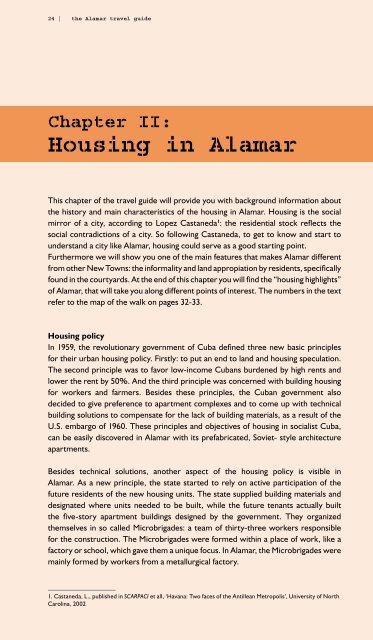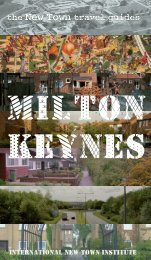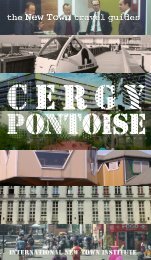Create successful ePaper yourself
Turn your PDF publications into a flip-book with our unique Google optimized e-Paper software.
24 | the <strong>Alamar</strong> travel guide<br />
Chapter II:<br />
Housing in <strong>Alamar</strong><br />
This chapter of the travel guide will provide you with background information about<br />
the history and main characteristics of the housing in <strong>Alamar</strong>. Housing is the social<br />
mirror of a city, according to Lopez Castaneda 1 : the residential stock reflects the<br />
social contradictions of a city. So following Castaneda, to get to know and start to<br />
understand a city like <strong>Alamar</strong>, housing could serve as a good starting point.<br />
Furthermore we will show you one of the main features that makes <strong>Alamar</strong> different<br />
from other New Towns: the informality and land appropiation by residents, specifically<br />
found in the courtyards. At the end of this chapter you will find the “housing highlights”<br />
of <strong>Alamar</strong>, that will take you along different points of interest. The numbers in the text<br />
refer to the map of the walk on pages 32-33.<br />
Housing policy<br />
In 1959, the revolutionary government of Cuba defined three new basic principles<br />
for their urban housing policy. Firstly: to put an end to land and housing speculation.<br />
The second principle was to favor low-income Cubans burdened by high rents and<br />
lower the rent by 50%. And the third principle was concerned with building housing<br />
for workers and farmers. Besides these principles, the Cuban government also<br />
decided to give preference to apartment complexes and to come up with technical<br />
building solutions to compensate for the lack of building materials, as a result of the<br />
U.S. embargo of 1960. These principles and objectives of housing in socialist Cuba,<br />
can be easily discovered in <strong>Alamar</strong> with its prefabricated, Soviet- style architecture<br />
apartments.<br />
Besides technical solutions, another aspect of the housing policy is visible in<br />
<strong>Alamar</strong>. As a new principle, the state started to rely on active participation of the<br />
future residents of the new housing units. The state supplied building materials and<br />
designated where units needed to be built, while the future tenants actually built<br />
the five-story apartment buildings designed by the government. They organized<br />
themselves in so called Microbrigades: a team of thirty-three workers responsible<br />
for the construction. The Microbrigades were formed within a place of work, like a<br />
factory or school, which gave them a unique focus. In <strong>Alamar</strong>, the Microbrigades were<br />
mainly formed by workers from a metallurgical factory.<br />
1. Castaneda, L., published in SCARPACI et all, ‘Havana: Two faces of the Antillean Metropolis’, University of North<br />
Carolina, 2002




